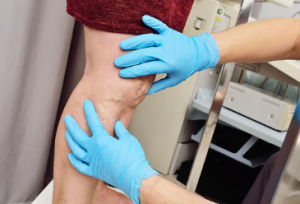Noninvasive Varicose Vein Treatment
A doctor uses ultrasound technology to find the vein to be treated and inject a sclerosing foam agent into it. This agent causes the vein to collapse and shrink, allowing blood to flow in a healthier vein. The treatment is usually painless and takes 30 to 45 minutes. Multiple sessions may be necessary depending on the number of affected veins.
 Noninvasive Varicose Vein Treatment Adelaide is an option that does not involve any surgery. These treatments can include foam sclerotherapy, thermal ablation, and local anesthesia, and each of these methods has its benefits and drawbacks. Learn about all your options and make the right decision for you.
Noninvasive Varicose Vein Treatment Adelaide is an option that does not involve any surgery. These treatments can include foam sclerotherapy, thermal ablation, and local anesthesia, and each of these methods has its benefits and drawbacks. Learn about all your options and make the right decision for you.
Before the procedure, patients must be examined for possible heart conditions, underlying blood vessel diseases, and a history of blood clots. They are also advised not to shave or apply lotion to the treated area the day before. In addition, patients should wear loose clothing, and shorts are the best choice.
Foam Sclerotherapy is an ultrasound-guided procedure often performed in conjunction with an endovenous ablation procedure. The sclerosant is a solution that looks like shaving cream and liquefies in a few minutes. This sclerosant can be effective for small to medium-sized varicose veins.
The procedure is usually an outpatient procedure. Patients should wear shorts to the procedure and have someone drive them home. Patients should also avoid strenuous exercise for a week. Patients may be prescribed acetaminophen to ease any pain. Aspirin or ibuprofen may interfere with blood clotting, so taking them during the procedure is not recommended.
While this treatment has drawbacks, it is a noninvasive alternative to invasive varicose vein surgery. It has the potential to reduce re-growth. It can also reduce leg muscle pain and cramps. During the recovery time, patients should wear elastic stockings to prevent swelling. It is also essential to encourage regular walking to relieve the symptoms associated with varicose veins.
Thermal ablation
Thermal ablation for non-invasive varicosity treatment is a procedure in which the abnormal vein is sealed off almost entirely. Typically, the procedure is performed on small, superficial varicose veins. Some patients require additional treatments after ablation, such as sclerotherapy or phlebectomy. The physician will schedule subsequent treatments as needed.
The noninvasive treatment is usually performed in a doctor’s office with a local anesthetic. Before the procedure, patients should inform their doctor of any allergies or medications. They should also stop taking blood thinners before the procedure, as these may cause blood clotting. The procedure typically lasts thirty to sixty minutes. Some patients may need to repeat the procedure.
Thermal ablation for noninvasive varicosity treatment is an outpatient procedure that involves radiofrequency technology. This technology uses a radiofrequency catheter to heat the vein. After the procedure, the vein is closed and will naturally reroute to other healthy veins. Patients can walk immediately following the procedure, but they will require graduated compression stockings to minimize any pain.
Thermal ablation for noninvasive varicosity treatment uses a small catheter to guide the energy into the varicose vein. The small tube is inserted into the vein through a tiny incision and guides the energy through the vein. First, a small amount of local anesthetic is applied to the site where the catheter is placed. Then, an ultrasound transducer is used to study the vein and track its path.
The procedure is safe and effective and takes approximately 30 to 60 minutes to complete. The procedure can be performed under general or regional anesthesia. Afterwards, patients may experience bruising, which usually goes away after a few weeks. After the procedure, patients can resume light activities, including walking for ten minutes a day.
Thermal ablation is a breakthrough in noninvasive varicose vein treatment. This endovascular technique treats the vein from within, offering a quick recovery time and minimal scarring. It uses a tiny catheter and is done with local anesthesia.
Tumescent anesthesia
The procedure requires a local anesthetic and a 45-90 minute stay in the room. The time required will depend on the number of concurrent veins, the length of the treated segment(s), and any ancillary procedures. Patients generally report high satisfaction after the procedure.
In some cases, patients may experience pain during noninvasive varicose vein treatment. Endovenous laser ablation is another treatment option. This procedure is less painful and less likely to cause nerve damage than tumescent anesthesia. Both methods can be performed in the same vein.
You May Also Like

Wildlife and Fisheries Resources Program
August 4, 2019
The Forest Resources Management Program
August 28, 2021
